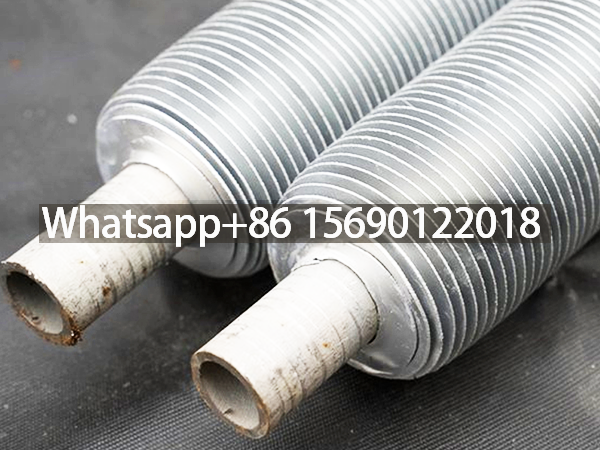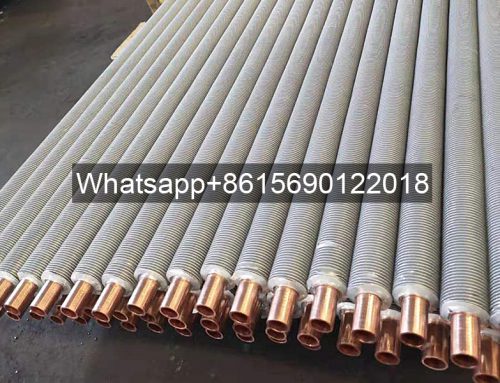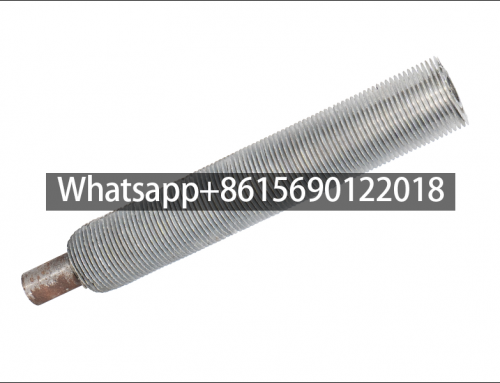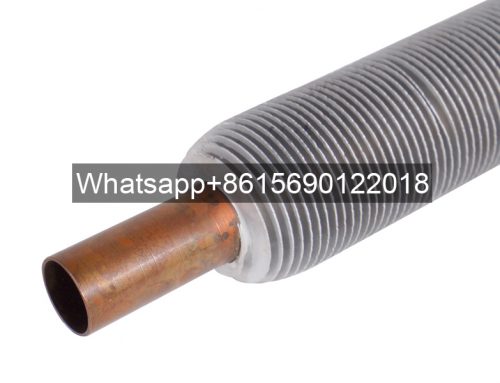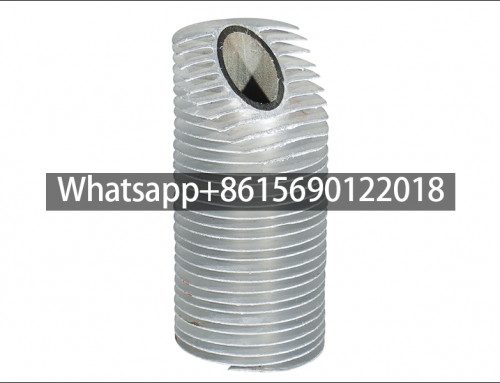Project Description
Aluminum Extruded Fin Tube for Evaporator
- Product Name: Aluminum Extruded Fin Tube for Evaporator
- Leave Your Message
1. Structural features of aluminum extruded fin tube for evaporator
Steel-aluminum composite fin tube is a special structure fin tube made of steel and aluminum. The base tube is usually made of steel tube, which has good strength and pressure bearing capacity. It can stably withstand the pressure of the internal medium and various external forces during the operation of the evaporator to ensure the stability of the entire structure.
The fin part is made of aluminum. Aluminum has excellent thermal conductivity and can quickly conduct heat away, which is crucial for the evaporator to efficiently complete the heat exchange task.
Through special processing techniques, such as mechanical expansion and hydraulic expansion, the aluminum fins are tightly attached to the outer surface of the steel tube, so that a good heat conduction channel is formed between the two, and the connection is firm. It is not easy to loosen or fall off under complex working conditions such as long-term alternation of hot and cold and fluid impact.
This steel-aluminum composite structure cleverly combines the strength advantage of steel with the thermal conductivity advantage of aluminum. At the same time, the presence of fins greatly increases the overall heat dissipation area of the tube. Compared with the light tube, its heat dissipation area can be doubled, providing a strong structural foundation for the rapid exchange of heat in the evaporator.
Datang fin tube manufacturer has 260 permanent employees, 15 R&D team, 8 thermal calculations, 5 hydropower engineers, an independent after-sales service team, and sales and service agencies are set up in major heating areas.
2. Working principle of aluminum extruded fin tube for evaporator
When the low-temperature and low-pressure liquid refrigerant to be evaporated enters the steel-aluminum composite fin tube inside the evaporator, the external heat source will contact the outside of the fin tube.
Due to the good thermal conductivity of the aluminum fin, the heat will be quickly transferred from the external heat source to the aluminum fin, and then through the close bonding surface between steel and aluminum, the heat will be further transferred to the refrigerant inside the steel tube.
After the refrigerant absorbs heat, it begins to change phase, gradually transforming from liquid to gas. In this process, it continuously absorbs heat from the outside, realizing the key function of the evaporator to transfer external heat to the refrigerant, thereby providing continuous power for the entire refrigeration cycle system.
3. Performance advantages of aluminum extruded fin tubes for evaporators
Efficient heat exchange: The steel-aluminum composite fin tube achieves efficient heat exchange efficiency with the excellent thermal conductivity of the aluminum fins and the greatly increased heat dissipation area.
In the evaporator, this means that the refrigerant can be evaporated faster, improving the cooling speed and cooling capacity of the entire refrigeration system, allowing the evaporator to achieve the ideal cooling effect in a shorter time, and meeting the needs for rapid cooling in different application scenarios.
Corrosion resistance: The environment in which the evaporator is located may sometimes be more complex, such as the presence of a certain humidity or trace corrosive gases.
The aluminum fins in the aluminum extruded finned tube will naturally form a dense aluminum oxide protective film on the surface, which has a certain resistance to some common corrosion factors. At the same time, if the steel tube part is properly treated with anti-corrosion, the entire finned tube can operate stably in a relatively harsh environment, extending the service life and reducing equipment failures and replacement costs caused by corrosion.
Lightweight and cost control: Compared with some finned tube structures that are all made of metal and have a high density, the steel-aluminum composite finned tube takes advantage of the relatively light characteristics of aluminum, so that the entire evaporator equipment can achieve a certain degree of lightweight while ensuring performance, which is more beneficial for some installation scenarios that require equipment weight.
The cost of aluminum is relatively low compared to some precious metals. In large-scale production applications, it helps to control the overall production cost of the evaporator and improve the market competitiveness of the product.
4. Application and maintenance of aluminum extruded finned tubes for evaporators
It plays an important role in the fields of industrial refrigeration, refrigeration equipment evaporators in cold chain logistics and transportation, and can adapt to different working conditions and refrigeration scale requirements.
In terms of maintenance, due to its structural characteristics, it is necessary to regularly check the integrity of the fins to see if there are any deformations or collapses that affect the heat exchange efficiency; at the same time, pay attention to whether there are any signs of looseness at the steel-aluminum joint, and whether there are any corrosion marks on the surface of the tube.
In daily use, it is also a very important maintenance measure to keep the external environment of the evaporator clean and avoid excessive accumulation of dust and debris on the surface of the fin tube to affect heat transfer. Through these reasonable maintenance methods, the steel-aluminum composite fin tube can be guaranteed to continuously and stably perform its excellent performance in the evaporator.
Aluminum Extruded Finned Tubes for Evaporators: Structure and Performance
1. Structural Characteristics
- Bimetal Composite Design:
- Steel Base Tube: Provides mechanical strength (withstands >3 MPa pressure) and structural stability under thermal cycling13.
- Aluminum Fins: High thermal conductivity (200-250 W/m·K) enables rapid heat dissipation13.
- Extrusion Bonding:
- Hydraulic/mechanical expansion creates metallurgical bonds with interfacial contact ratio >99%, eliminating air gaps and minimizing thermal resistance36.
- Surface Area Enhancement:
- Fin density: 150-400 fins/meter, increasing heat exchange area 8-10× versus bare tubes58.
| Component | Material | Key Property | Value/Advantage |
|---|---|---|---|
| Base Tube | Steel | Tensile Strength | ≥300 MPa18 |
| Fins | Aluminum | Thermal Conductivity | 200-250 W/m·K37 |
| Bond Interface | N/A | Contact Ratio | >99%6 |
2. Working Principle
- Cold refrigerant (e.g., R134a) absorbs heat through the steel tube wall.
- Aluminum fins rapidly transfer external heat to the refrigerant via the seamless steel-aluminum interface, triggering liquid-to-gas phase change13.
- Spiral/straight fin designs induce turbulence, breaking thermal boundary layers and enhancing evaporation efficiency58.
3. Performance Advantages
- Thermal Efficiency:
- Achieves heat transfer coefficients of 100-150 W/m²·K, accelerating evaporation rates by 3× compared to smooth tubes58.
- Corrosion Resistance:
- Natural Al₂O₃ layer protects fins in humid environments (pH 6-9), extending service life to 10-15 years37.
- Economic & Operational Benefits:
- Lightweight (aluminum density: 2.7 g/cm³) reduces installation costs by 25%37.
- Low material costs enable 20% savings over full-copper designs1.
| Performance Metric | Aluminum Finned Tube | Bare Tube | Improvement |
|---|---|---|---|
| Heat Transfer Area | 8-10× larger | Baseline | +700-900%5 |
| Evaporation Rate | 25-30 kg/(m²·h) | 8-10 kg/(m²·h) | 3×38 |
| Service Life (humid env.) | 10-15 years | 5-8 years | +100%7 |
4. Applications & Maintenance
- Key Sectors:
- Industrial refrigeration, cold chain logistics, and HVAC evaporators (operating temp: -40°C to 120°C)37.
- Maintenance Protocols:
- Inspect fin integrity quarterly (prevent deformation/fouling)1.
- Monitor steel-aluminum interfaces for delamination using ultrasonic testing6.
- Clean fins biannually to maintain >95% thermal efficiency7.
Leading Manufacturers: Companies like Datang employ 260+ specialists with dedicated R&D teams for customized solutions1.
Conclusion
Aluminum extruded finned tubes combine steel’s mechanical resilience (>300 MPa strength)8 with aluminum’s superior thermal conductivity (200-250 W/m·K)7. Their extrusion-bonded structure achieves near-perfect interfacial contact (>99%)6, enabling 3× faster evaporation rates38 and 25% cost savings over conventional designs1. These tubes are indispensable for high-efficiency evaporators in refrigeration and HVAC systems.


